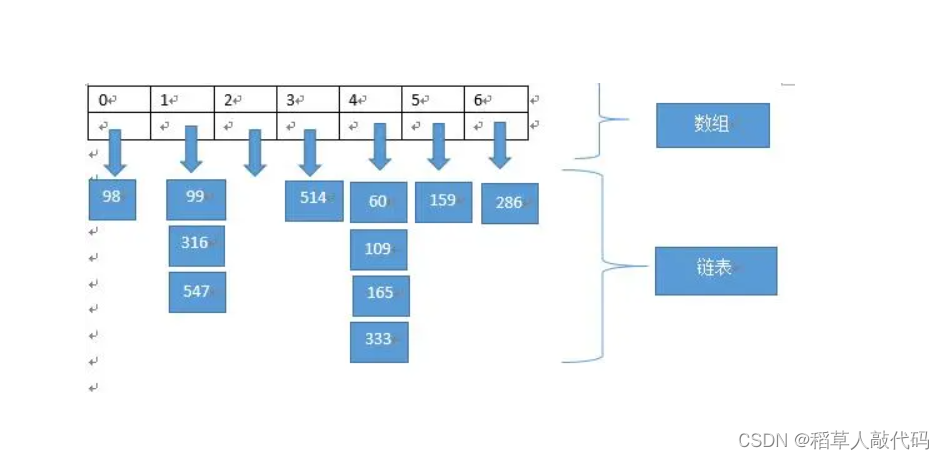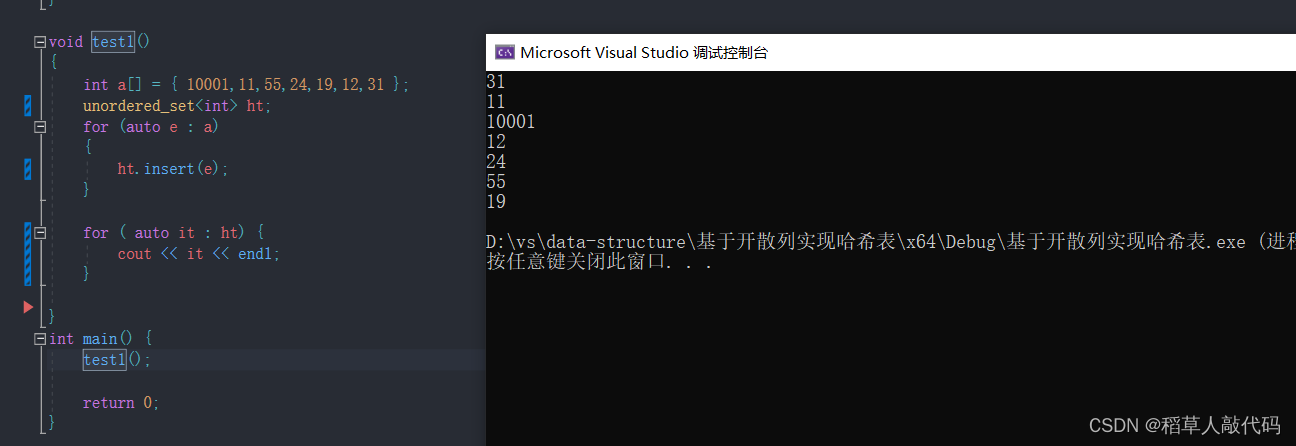文章目录
哈希表的概念
哈希表,也被称为散列表。是一种通过键可以快速找到对应值的一种数据结构。像我们常使用的unordered系列的容器,其本质就是一个哈希表。哈希表最显著的特点就是查找数据的效率非常的高,平均查找的时间复杂度为O(1)。通过哈希函数将键值映射到数组的具体位置,再对其进行操作。
哈希表查找的过程为:通过键来找到数组中的一个位置,通过这个位置我们能找到该键唯一映射的值。
哈希表的y重要设计模块就是哈希函数以及解决哈希冲突的方法。下面将对此做出解释:
哈希函数的设计
哈希表的性能的一个关键因素就是哈希函数的设计。具体的来说,哈希函数指的是通过键值找到映射到数组具体位置的方法。一个好的哈希函数能将键均匀的分布到哈希表的各个位置。
常见的哈希函数
- 直接定值法
取关键字的某个线性函数为散列地址,该线性函数的返回值应该是一个整数。比如Hash(key)=A*Key+B - 除留余数法
设散列表中允许的地址数为m,取一个不大于m,但最接近或者等于m的质数p作为除数,按照哈希函数:Hash(key) = key% p(p<=m),将关键码转换成哈希地址
哈希冲突
什么叫哈希冲突?哈希冲突又叫做哈希碰撞。具体是指,多个键通过一个哈希函数得到的位置相同。造成哈希冲突的主要原因是,哈希表的大小是有限的,而输入的数据可能会非常多,因此不可能避免出现哈希冲突。
那出现哈希冲突之后该如何解决呢?下面给出几种常见的解决哈希冲突的方法:
1. 闭散列
闭散列又叫开放定址法。当发生哈希冲突时,如果该哈希表还有空位,那么就从冲突位置开始往后找,直到找到空位。该如何往后找空位呢?一个一个找嘛?
- 线性探测:线性探测,从发生冲突的位置开始,一个一个往后面找,直到找到空位。

- 二次探测:从发生冲突的位置开始,使用一个二次探测公式来寻找下一个探测的位置,探测公式为:
H(k)=(Hash(k)+C1*i+C2*(i^2))%p- 其中
H(k)表示的是第i次探测的位置。 Hash(k)表示通过哈希函数得到的初始地址C1和C2是一个常数,C1通常为0,C2通常为1,即H(k)=(Hash(k)+(i^2))%pi是探测的次数,从0开始p是哈希表的大小
- 其中
二次探测的优点是能有效减少一次探测中数据过于“集中”的问题,即连续的冲突位置,会形成长链。而二次探测会使得探测的位置更加分散。
研究表明:当表的长度为质数且表装载因子a不超过0.5时,新的表项一定能够插入,而且任何一个位置都不会被探查两次。因此只要表中有一半的空位置,就不会存在表满的问题。在搜索时可以不考虑表装满的情况,但在插入时必须确保表的装载因子a不超过0.5,如果超出必须考虑增容。
装载因子又叫做负载因子,是哈希表中元素个数与哈希表大小的比值。
代码实现
哈希表类主要有两个模块需要实现,一个是节点类,还有一个是存储节点的容器。容器我们选择使用STL中的vector。对于节点类,我们希望至少能实现以下功能:
- 存储键值对
- 存储状态
值得注意的是,由于线性探测法的特性,删除一个元素之后可能会影响后续查找元素。我们需要给每个节点赋予三种状态表示:空节点、存在值得节点、被删除得节点。有了这三种种状态,我们在查找元素时,就不会因为中间曾经被删除的节点而影响。
#define _CRT_SECURE_NO_WARNINGS 1
#include<iostream>
#include<vector>
using namespace std;
namespace Close_Hash{
enum Statu{
EMPTY,
EXIST,
DEL
};
template<class K,class V>
struct Node {
Node():_statu(EMPTY){}
pair<K, V> _kv;
Statu _statu;
};
template<class K>
struct HashFunc{
size_t operator()(const K& key) {
return (size_t)key;
}
};
template<>
struct HashFunc<string> {
size_t operator()(const string& key) {
size_t res = 0;
for (auto it : key) {
int u = it - '0';
res = res * 131 + u;
}
return res;
}
};
template<class K,class V,class Hash=HashFunc<K>>
class HashTable {
public:
HashTable(size_t capacity = 10)
: _totalSize(0)
, _ht(capacity)
{
}
V& operator[](const K& key) {
Node<K, V>* node = Find(key);
if (node) {
return (node->_kv).second;
}
else {
this->Insert(make_pair(key,0));
return Find(key)->_kv.second;
}
}
// 插入
bool Insert(const pair<K, V>& val) {
//负载超标
if (_totalSize * 10 >= 7 * _ht.size()) {
HashTable<K, V> newtable;
newtable._ht.resize(_ht.size() * 2);
for (int i = 0; i < _ht.size(); i++) {
if (_ht[i]._statu == EXIST) {
newtable.Insert(_ht[i]._kv);
}
}
_ht.swap(newtable._ht);
}
Hash ha;
size_t pos = ha(val.first) % _ht.size();
//线性探测
while (_ht[pos]._statu == EXIST) {
pos++;
pos = pos % _ht.size();
}
_ht[pos]._kv = val;
_ht[pos]._statu = EXIST;
_totalSize++;
return true;
}
// 查找
Node<K,V>* Find(const K& key) {
Hash ha;
size_t pos = ha(key) % _ht.size();
while (_ht[pos]._statu != EMPTY) {
if (_ht[pos]._statu == EXIST && _ht[pos]._kv.first == key) {
return &_ht[pos];
}
pos++;
pos = pos % _ht.size();
}
return nullptr;
}
// 删除
bool Erase(const K& key) {
Node<K, V>* node = Find(key);
if (!node)return false;
node->_statu = DEL;
return true;
}
size_t Size() {
return _ht.size();
}
bool Empty() const
{
return _ht.empty();
}
private:
vector<Node<K,V>> _ht;
size_t _totalSize;
};
}
2. 开散列
开散列法又被叫做链地址法或者拉链法。和闭散列不同的是,具有相同地址的关键码属于同一集合,并用一个单链表维护这个集合。我们将这个集合称为桶。开散列得到哈希表的每一个元素实际上是一个名为桶的单链表。于是,当我们发生哈希冲突时,不用去哈希表中找空位了,因为当前桶是一个单链表,插入元素时直接头插就好了。

拉链法的优点
拉链法处理哈希冲突的效率是非常高的。即使多个元素通过哈希函数得到的地址是一样的,也不会显著影响哈希表的性能。此外,拉链法下的负载因子是可以超过1的,因此拉链法下的哈希表可以灵活的应对动态数据集的增长,不需要频繁的调整哈希表的大小。值得一提的是,虽然看上去会使用额外的空间来存放指针,但由于不需要严格维护平衡因子,空间效率并不会比开放定址法低。因为开放定址法需要开大量额外的空间来保证负载因子不溢出。
代码实现:
跟线性探测代码不一样的地方在于,拉链法的节点实际上是一个链表的头节点(桶)。所以对于哈希表的节点类,我们希望有以下功能:
- 指向下一个元素的指针
- 存储键值对
在插入元素时,将新节点插入到桶中。
#pragma once
#include<vector>
#include<iostream>
using namespace std;
namespace hash_bucket {
template<class K,class V>
struct HashNode {
HashNode(const pair<K, V>& kv)
: _kv(kv)
,_next(nullptr)
{
}
HashNode()
:_next(nullptr)
{
}
pair<K, V> _kv;
HashNode<K, V>* _next;
};
template<class K>
struct HashFunc {
size_t operator()(const K& k) {
return (size_t)k;
}
};
template<>
struct HashFunc<string> {
size_t operator()(const string& str) {
size_t res = 0;
for (auto it : str) {
int u = it;
res = res * 131 + u;
}
return res;
}
};
template<class K,class V,class Hash=HashFunc<K>>
class HashTable {
public:
typedef HashNode<K, V> Node;
typedef Node* pNode;
HashTable()
:_table(10, nullptr)
, _n(0)
{
}
//随机访问
V& operator[](const K& k) {
if (!Find(k)) {
Insert(make_pair(k,V()));
}
return Find(k)->_kv.second;
}
//插入
bool Insert(const pair<K, V>& kv) {
Hash ha;
//负载因子为1时扩容
if (_n == _table.size()) {
HashTable<K, V> newtable;
newtable._table.resize(_table.size() * 2);
for (size_t i = 0; i < _table.size(); i++) {
if (_table[i]) {
pNode cur = _table[i];
while (cur) {
pNode temp = cur->_next;
size_t pos = ha(cur->_kv.first) % newtable._table.size();
if (newtable._table[pos]) {
cur->_next = newtable._table[pos];
}
newtable._table[pos] = cur;
cur = temp;
}
}
}
_table.swap(newtable._table);
}
size_t pos = ha(kv.first) % _table.size();
pNode newnode = new Node(kv);
if (_table[pos] != nullptr) {
newnode->_next = _table[pos];
}
_table[pos] = newnode;
_n++;
return true;
}
//查找
pNode Find(const K& k) {
Hash ha;
size_t pos= ha(k) % _table.size();
pNode cur = _table[pos];
while (cur) {
if (cur->_kv.first == k)return cur;
cur = cur->_next;
}
return nullptr;
}
//删除
bool Erase(const K& k) {
Hash ha;
if (!Find(k))return false;
size_t pos = ha(k) % _table.size();
pNode pre = nullptr;
pNode cur = _table[pos];
if (cur->_kv.first == k) {
delete cur;
_table[pos] = nullptr;
return true;
}
else {
while (cur) {
if (cur->_kv.first == k) {
pre->_next = cur->_next;
delete cur;
cur = nullptr;
return true;
}
pre = cur;
cur = cur->_next;
}
return false;
}
}
private:
vector<pNode> _table;
int _n;//存储有效桶的个数
};
}
上述代码大致实现了基于开散列法的哈希表,支持键值对的插入,删除、查询以及修改。
注意开散列法哈希表的扩容方案。当负载因子达到一定值时,我们选择扩大哈希表的大小,对于旧哈希表的元素不用再重新拷贝构造,而是移植到新表中。这样就节省了很多空间。具体实现如下:
//负载因子为1时扩容
if (_n == _table.size()) {
HashTable<K, V> newtable;//新表
newtable._table.resize(_table.size() * 2);
for (size_t i = 0; i < _table.size(); i++) {
if (_table[i]) {//遍历旧表,移植节点
pNode cur = _table[i];
while (cur) {
pNode temp = cur->_next;
size_t pos = ha(cur->_kv.first) % newtable._table.size();
if (newtable._table[pos]) {
cur->_next = newtable._table[pos];
}
newtable._table[pos] = cur;
cur = temp;
}
}
}
_table.swap(newtable._table);
}
针对开散列哈希的扩展
如何给上述开散列哈希表类增加迭代器呢?
由于迭代器中需要访问哈希表而不仅仅是桶,而哈希表又属于哈希表类的私有成员。因此,设计迭代器模块时,我们可以将迭代器类设置为哈希表类的内部类。而一个类的内部类是这个类的友元,因此迭代器就能访问到哈希表。给出以迭代器代码,每一个迭代器对象指向哈希表中桶内的一个节点:
//迭代器内部类
template<class Ptr, class Ref>
struct _HashIterator {
typedef _HashIterator<Ptr, Ref> self;
pNode _node;
const HashTable* _pht;
_HashIterator(pNode pnode, const HashTable* pht)
:_node(pnode)
, _pht(pht)
{
}
Ref operator*() {
return _node->_data;
}
Ptr operator->() {
return &_node->_data;
}
self& operator=(const self it) {
_node = it._node;
_pht = it._pht;
return *this;
}
self& operator++() {
if (_node->_next) {
_node = _node->_next;
}
else {
KeyOft kft;
Hash ha;
size_t pos = ha(kft(_node->_data)) % _pht->_table.size();
size_t i = pos + 1;
for (; i < _pht->_table.size(); i++) {
if (_pht->_table[i]) {
break;
}
}
if (i == _pht->_table.size()) {
_node = nullptr;
}
else {
_node = _pht->_table[i];
}
}
return *this;
}
bool operator!=(const self& iterator) {
return iterator._node != _node;
}
};
该迭代器主要实现了重载操作符的作用,希望能将迭代器当指针来使用。
基于开散列拉链法封装哈希表
MyHash.h
该文件封装实现了一个哈希表类,哈希函数是除留余数,解决哈希冲突的方法采用拉链法。
代码:
#pragma once
#include<vector>
#include<iostream>
using namespace std;
namespace hash_bucket {
template<class T>
struct HashNode {
HashNode(const T& data)
: _data(data)
, _next(nullptr)
{
}
HashNode()
:_next(nullptr)
{
}
T _data;
HashNode<T>* _next;
};
template<class K>
struct HashFunc {
size_t operator()(const K& k) {
return (size_t)k;
}
};
template<>
struct HashFunc<string> {
size_t operator()(const string& str) {
size_t res = 0;
for (auto it : str) {
int u = it;
res = res * 131 + u;
}
return res;
}
};
template<class K, class T, class KeyOft, class Hash = HashFunc<K>>
class HashTable {
public:
typedef HashNode<T> Node;
typedef Node* pNode;
HashTable()
:_table(10, nullptr)
, _n(0)
{
}
//迭代器内部类
template<class Ptr, class Ref>
struct _HashIterator {
typedef _HashIterator<Ptr, Ref> self;
pNode _node;
const HashTable* _pht;
_HashIterator(pNode pnode, const HashTable* pht)
:_node(pnode)
, _pht(pht)
{
}
Ref operator*() {
return _node->_data;
}
Ptr operator->() {
return &_node->_data;
}
self& operator=(const self it) {
_node = it._node;
_pht = it._pht;
return *this;
}
self& operator++() {
if (_node->_next) {
_node = _node->_next;
}
else {
KeyOft kft;
Hash ha;
size_t pos = ha(kft(_node->_data)) % _pht->_table.size();
size_t i = pos + 1;
for (; i < _pht->_table.size(); i++) {
if (_pht->_table[i]) {
break;
}
}
if (i == _pht->_table.size()) {
_node = nullptr;
}
else {
_node = _pht->_table[i];
}
}
return *this;
}
bool operator!=(const self& iterator) {
return iterator._node != _node;
}
};
typedef _HashIterator<T*, T&> Iterator;
typedef _HashIterator<const T*, const T&> Const_Iterator;
//迭代器
Iterator begin() {
for (size_t i = 0; i < _table.size(); i++) {
if (_table[i]) {
return Iterator(_table[i], this);
}
}
return Iterator(nullptr, this);
}
Iterator end() {
return Iterator(nullptr, this);
}
Const_Iterator begin()const {
for (size_t i = 0; i < _table.size(); i++) {
if (_table[i]) {
return Iterator(_table[i], this);
}
}
return Iterator(nullptr, this);
}
Const_Iterator end() const {
return Iterator(nullptr, this);
}
//随机访问
/*V& operator[](const K& k) {
if (!Find(k)) {
Insert(make_pair(k,V()));
}
return Find(k)->_kv.second;
}*/
//插入
pair<Iterator, bool> Insert(const T& val) {
Hash ha;
KeyOft kft;
Iterator it = Find(kft(val));
if (it._node != nullptr)return make_pair(it, false);
//负载因子为1时扩容
if (_n == _table.size()) {
HashTable<K, T, KeyOft> newtable;
newtable._table.resize(_table.size() * 2);
for (size_t i = 0; i < _table.size(); i++) {
if (_table[i]) {
pNode cur = _table[i];
while (cur) {
pNode temp = cur->_next;
size_t pos = ha(kft(cur->_data)) % newtable._table.size();
if (newtable._table[pos]) {
cur->_next = newtable._table[pos];
}
newtable._table[pos] = cur;
cur = temp;
}
}
}
_table.swap(newtable._table);
}
size_t pos = ha(kft(val)) % _table.size();
pNode newnode = new Node(val);
if (_table[pos] != nullptr) {
newnode->_next = _table[pos];
}
_table[pos] = newnode;
_n++;
return make_pair(Iterator(newnode, this), true);
}
//查找
Iterator Find(const K& k) {
Hash ha;
KeyOft kft;
size_t pos = ha(k) % _table.size();
pNode cur = _table[pos];
while (cur) {
if (kft(cur->_data) == k)return Iterator(cur, this);
cur = cur->_next;
}
return Iterator(nullptr, this);
}
//删除
bool Erase(const K& k) {
Hash ha;
KeyOft kft;
if (!Find(k))return false;
size_t pos = ha(k) % _table.size();
pNode pre = nullptr;
pNode cur = _table[pos];
if (kft(cur->_data) == k) {
delete cur;
_table[pos] = nullptr;
return true;
}
else {
while (cur) {
if (kft(cur->_data) == k) {
pre->_next = cur->_next;
delete cur;
cur = nullptr;
return true;
}
pre = cur;
cur = cur->_next;
}
return false;
}
}
private:
vector<pNode> _table;
int _n;
};
}
基于哈希表实现unordered_map类
基于MyHash.h封装的哈希表类提供的接口,实现一个unordered_map。unordered_map的值是一个键值对。
Myunordered_map.h
该文件基本实现了unordered_map类。
代码:
#define _CRT_SECURE_NO_WARNINGS 1
#include"MyHash.h"
namespace bit {
template<class K, class V, class Hash = hash_bucket::HashFunc<K> >
class unordered_map {
struct MapKeyOft {
const K& operator()(const pair<K, V>& kv) {
return kv.first;
}
};
public:
typedef typename hash_bucket::HashTable<K, pair<const K, V>, MapKeyOft, Hash>::Iterator iterator;
//typedef typename hash_bucket::HashTable<K, pair<const K, V>, KeyOft, Hash>::Const_Iterator const_iterator;
iterator begin() {
return _ht.begin();
}
iterator end() {
return _ht.end();
}
V& operator[](const K& k) {
pair<iterator,bool>res=insert(make_pair(k, V()));
return res.first->second;
}
pair<iterator, bool> insert(const pair<K,V>& kv) {
return _ht.Insert(kv);
}
bool erase(const K& k) {
return _ht.Erase(k);
}
pair<iterator, bool> find(const K& k) {
return _ht.Find(k);
}
private:
hash_bucket::HashTable<K, pair<const K, V>, MapKeyOft, Hash> _ht;
};
}

基于哈希表实现unordered_set类
基于MyHash.h封装的哈希表类提供的接口,实现一个unordered_set类。
Myunordered_map.h
该文件基本实现了unordered_set类。
代码:
#include"MyHash.h"
namespace bit {
template<class K,class Hash = hash_bucket::HashFunc<K> >
class unordered_set {
struct SetKeyOft {
const K& operator()(const K& k) {
return k;
}
};
public:
typedef typename hash_bucket::HashTable<K, const K, SetKeyOft, Hash>::Iterator iterator;
typedef typename hash_bucket::HashTable<K, const K, SetKeyOft, Hash>::Const_Iterator const_iterator;
iterator begin() {
return _ht.begin();
}
iterator end() {
return _ht.end();
}
pair<iterator, bool> insert(const K& kv) {
return _ht.Insert(kv);
}
bool erase(const K& k) {
return _ht.Erase(k);
}
pair<iterator, bool> find(const K& k) {
return _ht.Find(k);
}
private:
hash_bucket::HashTable<K, const K, SetKeyOft, Hash> _ht;
};
}

























 1148
1148

 被折叠的 条评论
为什么被折叠?
被折叠的 条评论
为什么被折叠?








